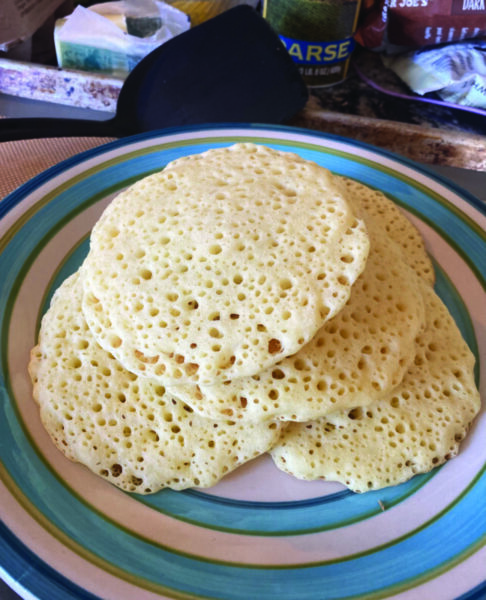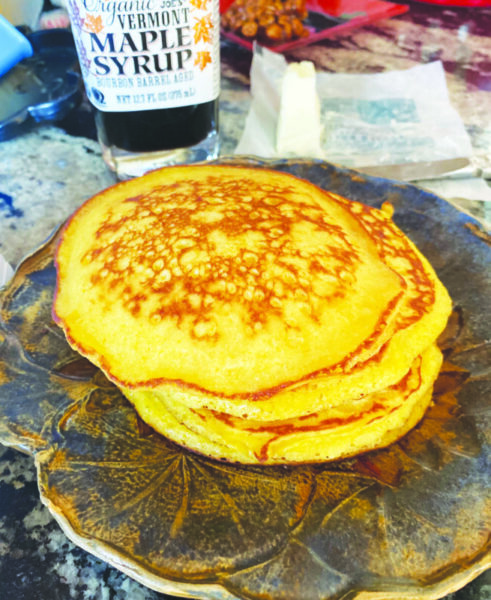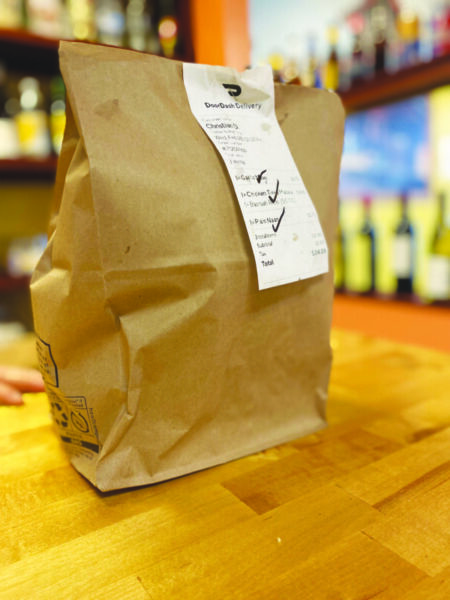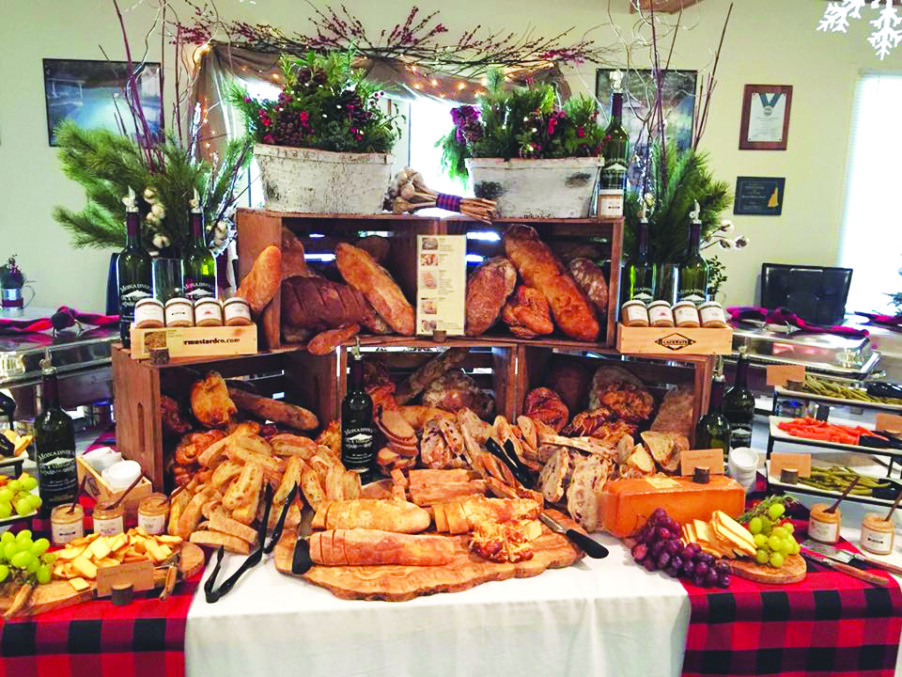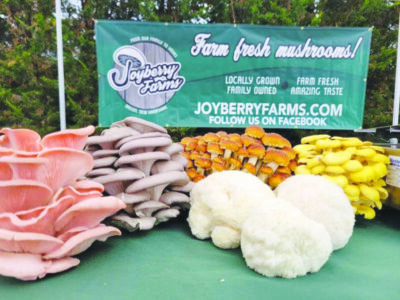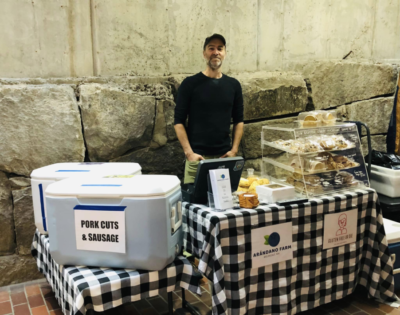Compiled by Amy Diaz
[email protected]
Spring is full of awesomeness.
Spring officially began March 19 and unofficially ends Memorial Day weekend when we start to slide into summer mode. Between now and then there are oodles of fun indoor, outdoor, artsy, music-y, foodie, bookworm-ish things happening. Here are 99 to consider putting on your calendar.
1. Golf! In a Facebook post last week, Derryfield Golf Course & Country Club (625 Mammoth Road in Manchester; derryfieldgolf.com, 669-0235) announced that nine holes would open on March 18. Call or go online to book a tee time.
2. Watch some indoor hockey action at the Black Ice Pond Hockey Championships Friday, March 22, through Sunday, March 24, at Tri-Town Ice Arena in Hooksett. The games are free to watch. See blackicepondhockey.com and the event’s Facebook page for schedule updates.
3. Skate! Kick off your weekend at Remix Skate & Event Center (725 Huse Road in Manchester; skateremix.com, 912-7661), which offers all-ages roller skating from 3 to 8 p.m. and 18+ Friday Night Flashbacks from 8:30 to 11 p.m., with a DJ — on Friday, March 22, the scheduled DJ is DJ Steve Fox, according to the venue’s Facebook page. Tickets for the adult portion of the evening cost $20 (which includes skate rental). See the website for tickets and for the rest of the week’s schedule.
4. Get kooky at the Pinkerton Players production of The Addams Family at the Stockbridge Theatre (44 N. Main St. in Derry; stockbridgetheatre.showare.com) on Friday, March 22, and Saturday, March 23, at 7 p.m. and Sunday, March 24, at 2 p.m. Tickets cost $15.
5. Root for the lacrosse teams at Southern New Hampshire University. The men’s team’s next home game is scheduled for Saturday, March 23, at 1 p.m. at Mark A. Ouellette Stadium on the SNHU campus (the stadium is on Victory Lane in Hooksett) versus American International College. The women’s next home game is Friday, March 22, at 5 p.m. versus Franklin Pierce University. Regular season games are free to attend; see snhupenmen.com for the full schedule.
6. Get more maple. Ben’s Sugar Shack (8 Webster Hwy. in Temple; bensmaplesyrup.com) continues its tours of the syrup operation on Saturday, March 23, and Sunday March 24, as well as Saturday, March 30, from 10 a.m. to 4 p.m., according to the website.
7. Catch Rivier Raiders men’s baseball on Sunday, March 30, when they play a doubleheader against Norwich at noon and 3 p.m. at Historic Holman Stadium (67 Amherst St. in Nashua). The women’s softball team plays at Raider Diamond and their first home games will be against Fitchburg State on Saturday, March 23, at 11 a.m. and 1 p.m. Games are free to attend. See rivierathletics.com.
8. Cheer the Rivier College Raiders men’s and women’s lacrosse teams. The next home game for the men’s lacrosse team will be Saturday, March 23, at noon, on Joanne Merrill Field at Linda Robinson Pavilion when they face Dean College. The women’s team’s next home game is Saturday, March 30, at noon when they face New England College. The games are free to attend. See rivierathletics.com.
9.Watch the Southern New Hampshire University Penmen baseball team play the Saint Anselm Hawks at Penmen Field on Wednesday, March 27, at 3 p.m. The women’s softball team will play a doubleheader against Mercy University at home on Saturday, March 23, with games at noon and 2 p.m. at the SNHU Softball Field (on Eastman Drive). The women will then play American International College on Sunday, March 24, at noon and 2 p.m. See snhupenmen.com for the schedule.
10. Catch Avenged Sevenfold with special guests Poppy and Sullivan King on Saturday, March 23, at 6:30 p.m. at the SNHU Arena (555 Elm St. in Manchester; snhuarena.com). Tickets cost $34.95 through $129.95.
11. Laugh at the Mike Koutrobis Comedy Special Recording onSaturday, March 23, at 8 p.m. at the Nashua Center for the Arts (201 Main St.; nashuacenterforthearts.com). Tickets cost $27. See the story on page 36.
12. Hear the Sounds of Seattle, a show featuring Five Against None (a Pearl Jam tribute band) and Song Garden (a Chris Cornell tribute band) on Saturday, March 23, at 9 p.m. at Angel City Music Hall (179 Elm St. in Manchester; angelcitymusichall.com). Tickets cost $10 for this 21+ show. See the website for Angel City’s full line-up this spring, including Legends of Rock night on Saturday, April 27, featuring tributes to AC/DC, Social Distortion and the Ramones.
13. Keep the St. Patrick’s Day spirit going at the Manchester St. Patrick’s Day Parade on Sunday, March 24, at noon on Elm Street stepping off from Salmon and Elm streets and heading to Central and Elm streets, according to saintpatsnh.com. The Citizens Shamrock Shuffle, a 2-mile run/walk on Elm Street, starts at 11 a.m. (with a Lil’ Leprechaun Run for ages 8 and under at 10:30 a.m); see millenniumrunning.com/shamrock for details on the race and to register.
14. Listen to author Chris Bohjalian discuss his works including his newest book The Princess of Las Vegas in conversation with NHPR’s Rick Ganley on Wednesday, March 27, at 7 p.m. at BNH Stage (16 S. Main St. in Concord; ccanh.com). Tickets cost $39 for one person and one hardcover copy of The Princess of Las Vegas or $49 for two admissions and one book. Author Julia Alvarez will also appear on the BNH Stage this spring on Monday, April 15, at 7 p.m. In the Chubb Theatre, also part of the Capitol Center for the Arts’ stages, author David Sedaris will talk on Sunday, April 21, at 7 p.m. and author Erik Larson will discuss his work on Tuesday, May 21, at 7 p.m.
15. Enjoy “An Evening of A Capella with Tonehenge and the Afternotes” on Wednesday, March 27, at 7:30 p.m. at the Concord City Auditorium (2 Prince St. in Concord; theaudi.org). Admission is free, doors open at 7 p.m. Other shows at the Audi this spring include William Florian in Concord on April 13 and The Shana Stack Band on April 24.
16. Read readers’ picks! Hippo’s Best of 2024 is slated to hit streets next week, Thursday, March 28. Get all the winners in categories like best pizza, best margarita, best doughnut and some things that have nothing to do with food.
17. Thou shalt check out Cecil B. DeMille’s first crack at The Ten Commandments, the 1923 silent film that blends the story of Moses with a modern (1920s modern) story, which will screen with live musical accompaniment by Jeff Rapsis on Thursday, March 28, at 7 p.m. at the Rex Theatre (23 Amherst St. in Manchester; palacetheatre.org). Tickets cost $10.
18. Watch the movies of the Wild & Scenic Film Festival on Friday, March 29, with a reception at 6 p.m. and screening at 7 p.m. at the BNH Stage (16 S. Main St. in Concord; ccanh.com). See the website for different ticket packages including an online-only option.
19. Put on your fuzzy ears and your unicorn horn for a presentation of Bubbly Beautiful Kitty-Corn by the book’s author Shannon Hale and illustrator LeUyen Pham, creators of the Kitty-Corn series, on Friday, March 29, at 6:30 p.m. at Gibson’s Bookstore (45 S. Main St. in Concord; gibsonsbookstore.com). Other author events this spring include Howard Mansfield for his book I Will Tell No War Stories on April 25 and Jilly Gagnon with her book Love You, Mean It on May 7.
20. Shop Concord’s Giant Indoor Yard Sale on Saturday, March 30, from 9 a.m. to 2 p.m. at Everett Arena (15 Loudon Road in Concord), according to the arena’s schedule of events.
21. Get some Saint Anselm College Hawks lacrosse. The women’s team’s next home game is Saturday, March 30, at noon against the D’Youville University Saints. The men’s team will play its next home game on Saturday, March 30, at 3:30 p.m. versus the Bentley University Falcons. Both games take place at Grappone Stadium on the Saint Anselm College campus in Manchester. See saintanselmhawks.com. Games are free to attend.
22. Cheer on the Saint Anselm College Hawks baseball team, whose upcoming home games include Saturday, April 6, and Sunday, April 7, at noon, both at Sullivan Park on the Saint Anselm College campus in Manchester. The women’s softball team will play their next home games on Saturday, March 30, at noon and 2 p.m., both against the Assumption Greyhounds, at the South Athletic Fields on the Saint Anselm College campus. See saintanselmhawks.com. Games are free to attend.
23. Root for your faves at Road to WrestleMania on Saturday, March 30, at 7:30 p.m. at the SNHU Arena (555 Elm St. in Manchester; snhuarena.com). Tickets cost $30 to $125.
24. Enjoy a chocolate bunny or a full brunch buffet with the many Easter eats offerings. Easter Sunday is March 31; check out all the dine-in and takeout food offerings in this week’s Hippo on page 26.
25. Laugh with the Queen City Improv troupe. They will perform on Monday, April 1, at Stark Brewing Co. (500 Commercial St. in Manchester) from 7 to 9 p.m. Or catch them at Chunky’s (707 Huse Road in Manchester; chunkys.com) on Friday, April 19, at 8 p.m., where tickets cost $20. See all of their upcoming shows at queencityimprov.com.
26. Listen to a conversation between writers Joe Hill and Michael Koryta, who writes under the name Scott Carson, on Monday, April 1, from 7 to 8:30 p.m. at the Nashua Public Library (2 Court St. in Nashua). Tickets cost $10 for general admission, $39 for admission and a book. See nashualibrary.org.
27. Try new brews during NH Craft Beer Week 2024, running Thursday, April 4, through Saturday, April 13. The week will feature more than 120 events throughout New Hampshire, according to nhbrewers.org, where you can check back for updates of events including Pint Days (April 7-13).
28. Watch lots of movies at the New Hampshire Jewish Film Festival, which will run April 4 through April 14, with a bonus week of virtual screenings through April 21. The festival kicks off on Thursday, April 4, with a reception at 5:15 p.m. at the Spotlight Room at the Palace Theatre in Manchester followed by a screening at 7 p.m. of Remembering Gene Wilder. Events take place at theaters and locations throughout the state. See 2024nhjff.eventive.org for this year’s line-up of films and events and the available film ticket packages.
29. Meet Robert Frost when actor Gordon Clapp performs as the poet in Robert Frost: This Verse Businesson Thursday, April 4, at 7 p.m. at the Stockbridge Theatre (44 N. Main St. in Derry; stockbridgetheatre.showare.com). Tickets cost $25 and $30.
30. Catch Club D’Elf on Thursday, April 4, at 7:30 p.m. at BNH Stage (16 S. Main St. in Concord; ccanh.com). Tickets cost $30.75 in advance, an additional $5 at the door. The BNH Stage will feature several other concerts this spring including Senie Hunt (in the Cantin Room) on April 7, Mullett on May 18 and the Granite State Blues Challenge on May 19.
31. See Rufus Wainwright perform on Thursday, April 4, at 8 p.m. at the Tupelo Music Hall (10 A St. in Derry; tupelomusichall.com), one of the venue’s many standout shows this spring. Tickets cost $54 or $59. Other shows on the schedule include Spyro Gyra’s 50th Anniversary tour (March 23 at 8 p.m.), comedy night on April 13, Tusk (Fleetwood Mac tribute) on April 20 and more.
32. Meet Pete the Cat at the Books Alive! event at the Children’s Museum of New Hampshire (6 Washington St. in Dover; childrens-museum.org) on Friday, April 5, at either 10 a.m. or 2 p.m. and Saturday, April 6, at either 10 a.m. or 2 p.m. On both days, play sessions are from 9 a.m. to noon or 1 to 4 p.m. (the Friday also features “First Friday” play time from 4:15 to 7 p.m.). Admission costs $12.50 for adults and kids over 12 months old, $10.50 for 65+.
33. Shop the Made In NH “Try It & Buy It Expo” scheduled for Friday, April 5, from 1 to 7 p.m.; Saturday, April 6, from 10 a.m. to 5 p.m., and Sunday, April 7, from 10 a.m. to 4 p.m. at the Center of New Hampshire Expo Center, DoubleTree By Hilton Manchester Downtown Hotel. Admission costs $8 for adults, $7 for 65+, and is free for kids under 14, according to businessnhmagazine.com/events/made-in-nh-expo, where you can purchase tickets.
34. Sing “bum bum BUM” when So Good: the Neil Diamond Experience tribute show comes to the Palace Theatre (80 Hanover St. in Manchester; palacetheatre.org) on Friday, April 5, at 7:30 p.m. Tickets cost $29 to $39.
35. Hear the American Spiritual Ensemble, described as featuring singers, an accompanist and an African drummer having a “repertoire ranging from spirituals to classical to jazz and Broadway numbers highlighting the Black experience” on Friday, April 5, at 8 p.m. at the Capitol Center for the Arts’ Chubb Theatre (44 S. Main St. in Concord; ccanh.com). Tickets cost $43.75. The show is one of many concerts at the Cap Center this spring including Buddy Guy on April 12, Gregorian: Pure Chants in Concert on April 20, Straight No Chaser on their Yacht Rock Tour on May 5, and Kansas on May 10.
36. Find new reads, meet authors and get tips for writing your own book at the Derry Author Fest onSaturday, April 6, from 10 a.m. to 4 p.m. at Derry Public Library (64 E. Broadway, Derry, 432-6140, derrypl.org), which will feature workshops, panels and networking for aspiring authors and dabblers. Attendees can stay all day or just drop in for a session. Book sales and signings are interspersed between workshops. The day begins with a keynote address from Virginia MacGregor. See derryauthorfest.wordpress.com/schedule for a detailed schedule.
37. Shop the Capital City Craft Festival on Saturday, April 6, from 10 a.m. to 5 p.m. and Sunday, April 7, from 10 a.m. to 4 p.m. at the Everett Arena (15 Loudon Road in Concord) featuring more than 100 artisans selling arts, crafts, specialty foods and more, according to castleberryfairs.com. Admission costs $8 for adults, under 14 get in free.
38. Get literary at Exeter Litfest, a free event (donations welcome) on Saturday, April 6, at Exeter Town Hall (Front Street) and Exeter Library (4 Chestnut St.). A kick-off party will be held Friday, April 5, from 7 to 8:30 p.m. at Exeter Public Library with a free concert by Sharon Jones. Events on Saturday include a Crime and Mystery Brunch at Sea Dog restaurant, tickets required; an event with children’s authors Matt Tavares and Suzanne Slade at the Exeter Public Library at 11 a.m.; poetry readings, writers’ panels and author talks during the afternoon; a book-swap table; and a keynote address with Andre Dubus III at 4 p.m. at Exeter Town Hall. See exeterlitfest.com.
39. Get a taste of the classical music of Spain and Spanish composers at Bolero!, a concert from the New Hampshire Philharmonic on Saturday, April 6, at 7:30 p.m. and Sunday, April 7, at 2 p.m. at the Seifert Performing Arts Center (44 Geremonty Drive in Salem). Tickets cost $5 to $35 and the Sunday show has an online option. See nhphil.org.
40. Watch The Peking Acrobats on Sunday, April 7, at 4 p.m., one of several shows coming to the Nashua Center for the Arts this spring. Tickets cost $29 to $59. See nashuacenterforthearts.com for more on this and other shows such as Preacher Lawson (April 6), Adam Ezra Group (April 20), Rodrigo Y Gabriela (May 5) and more.
41. Get eye protection. There’s going to be a total solar eclipse on Monday, April 8, and the Granite State will have a good view of it (weather permitting). Northern New Hampshire will see the sun completely blocked, while the rest of the state will see it mostly blocked. Get your eclipse glasses before they sell out, if you want to look at the sun during the eclipse. Regular sunglasses are not good enough.
Then, check out one of these pre-eclipse events. On Wednesday, March 27, at 6:30 p.m., the New Hampshire Astronomical Society presents “What to Expect from a Solar Eclipse” at Derry Public Library (64 E. Broadway, Derry, derrypl.org, 432-6140); register to attend at the library’s website. See nhastro.com for more events from the Astronomical Society. On Tuesday, April 2, from noon to 1 p.m. Plymouth State University professor and planetarium director Dr. Brad Moser presents a “Lunch and Learn” at the Puritan Backroom in Manchester; tickets cost $15 per person, which includes a lunch buffet and a pair of solar eclipse viewing glasses. Get tickets at plymouth-usnh.nbsstore.net/lunch-and-learn-eclipse. And on Wednesday, April 3, from 6 to 8 p.m. the UNH Department of Physics and Astronomy welcomes the public to a free informal all-ages event, “The Science of Solar Eclipses,” on the UNH Durham campus. See extension.unh.edu/eclipse for details and lots of eclipse-related resources.
If you want to go up north for eclipse totality, check out visitnh.gov/solareclipse for viewing tips, event listings, and lodging information to make a night of it.
On eclipse day here in southern New Hampshire, McAuliffe-Shepard Discovery Center in Concord (2 Institute Dr., 271-7827) will have eclipse activities included with general admission from noon to 5 p.m., such as making a pinhole camera, eclipse puzzles and lunar phases wheels. As of March 14, eclipse glasses were still available in the Center’s store, $2.50 per pair. See starhop.com for details and eclipse info. And in Manchester, SEE Science Center will host an eclipse viewing event at Arms Park from 2 to 4:30 p.m. with music from WZID and activities to explain eclipse science. Visit see-sciencecenter.org for eclipse simulation videos and more. SEE’s gift shop has eclipse glasses for $2 per pair.
42. Buy your peanuts and Cracker Jack as the Fisher Cats hit the field for the first home game of the season on Tuesday, April 9, at 6:35 p.m. for the first of six games against the Somerset Patriots. On the schedule for the first games: The first 500 fans at Tuesday’s and Wednesday’s games get a magnet Fisher Cats’ schedule, mascot Fungo will get a birthday celebration on Friday (April 12), Saturday’s game (April 13, 4:05 p.m.) will celebrate the team’s 20th anniversary and Sunday’s game (April 14, 1:05 p.m.) will include “Kids Run the Bases” after the game. Other promotions include: Copa La Diversión when the team becomes the Gatos Feroces de New Hampshire (April 25 at 6:35 p.m.); Wizards & Wands on May 9 at 6:35 p.m.; and the Manchester Chicken Tenders night (when the team is briefly rebranded) on May 11 at 4:05 p.m. See milb.com/new-hampshire for the schedule and tickets.
43. Laugh with the comedy of Bob Marley, who will perform five shows at the Palace Theatre (80 Hanover St. in Manchester; palacetheatre.org) Thursday, April 11, through Sunday, April 14. Shows are at 7:30 p.m. every day except Saturday, when shows are at 5:30 and 8 p.m. Tickets cost $43.50.
44. Get poetic at the Nossrat Yassini Poetry Festival, a free weekend of readings, workshops, performances and prize winners hosted by the UNH English Department Friday, April 12, through Sunday, April 14, at the UNH Durham campus. Get the details at unhpoetry.com/about.
45. See the Majestic Theatre’s production of the comedy Birthday Club, described as “Five women get together for their birthdays, each with her own story, to drink, celebrate, commiserate and support each other,” on Friday, April 12, at 7 p.m.; Saturday, April 13, at 2 and 7 p.m. and Sunday, April 14, at 2 p.m. at the Majestic Theatre (880 Page St. in Manchester; majestictheatre.net). Tickets cost $15 to $20.
46. Enjoy another installment of “A Distant Conversation,” a series looking at the works of two artists, when “Filippo de Pisis and Robert Mapplethorpe: A Distant Conversation” opens on Saturday, April 13 (it runs through Monday, Sept. 2), at the Currier Museum of Art (150 Ash St. in Manchester; currier.org). April 13 is also the Second Saturday, when admission is free for New Hampshire residents, 10 a.m. to 5 p.m.
47. Find comics at the Little “Giant” Comics Old School Comics Show (oldschoolcomicshow.com) on Saturday, April 13, at Everett Arena (15 Loudon Road in Concord). Tickets cost $15 for general admission, $50 for VIP admission (an hour early at 9 a.m. plus a red carpet entrance and a goodie bag), and for $125 admission that includes a dinner on Friday, April 12, with Jim Steranko (described as “one of the most prolific artists in the history of comics”), according to the website. The show features comic book vendors and comic book artists, including what the show is billing as Venompolooza, a line-up of artists who have worked on Marvel’s Venom comics.
48. Celebrate Earth Day with the Stonyfield Earth Day 5K on Saturday, April 13, at 9 a.m. The race begins and ends at Londonderry’s West Soccer Complex, near the site of the Stonyfield Earth Day Fair. The day will also include a kids’ fun run, vendors, games, a beer garden for ages 21+ and more, according to millenniumrunning.com/stonyfield5k, where you can register.
49. Take the kids to the Nashua Chamber Orchestra’s free family concert on Saturday, April 13, at 2 p.m. at the Nashua Public Library (2 Court St. in Nashua). Kids can get an up-close look at the instruments, according to nco-music.org.
50. Catch one or both of the Candlelight concerts at the Rex Theatre (23 Amherst St. in Manchester; palacetheatre.org) on Wednesday, April 17. At 6 p.m. it’s “Vivaldi’s Four Seasons and More” and at 8:30 p.m. the show is “A Tribute to Adele.” Tickets to either show cost $43 to $60.
51. Join New Hampshire Roller Derby by checking out the Rookie Camp Meet and Greet on Thursday, April 18, at 6:30 p.m. at the Manchester Ballers Association (3 Sundial Ave. in Manchester), according to a post on the organization’s Facebook page. No experience is necessary. New Hampshire Roller Derby begins its lineup of home games with a mixed public scrimmage on Saturday, May 11, at 5 p.m. at JFK Memorial Coliseum (303 Beech St. in Manchester). See nhrollerderby.com.
52. See Beautiful: The Carole King Musical, which will runat the Palace Theatre (80 Hanover St. in Manchester; palacetheatre.org) Friday, April 19, through Sunday, May 12, with shows on Fridays at 7:30 p.m., Saturdays at 2 and 7:30 p.m., Sundays at 2 p.m. and Thursday, May 9, at 7:30 p.m. Tickets cost $28 to $49.
53. Rediscover vinyl on Record Store Day, Saturday, April 20, when participating stores will have special releases. Locally, participating indie stores include Metro City Records in Manchester, Music Connection in Manchester, Pitchfork Records in Concord, Toadstool Bookshop in Peterborough and Bull Moose in Salem, according to recordstoreday.com, where you can find more about the offerings.
54. Search for treasures at the Granite State Trading Cards & Collectibles Show on Saturday, April 20, 9 a.m. to 4 p.m. at Everett Arena (15 Loudon Road in Concord). Admission costs $5, free for 12 and under. See jimmysplacesportscards.com.
55. Celebrate Earth Day at the New Hampshire Audubon’s Massabesic Center (26 Audubon Way in Auburn; nhaudubon.org) on Saturday, April 20, from 10 a.m. to 3 p.m. The schedule includes a bird walk, amphibian exploration, a wildlife photography tour, the “Where Does It Go” game show, Raptor Encounter, a Caterpillar Lab presentation and an afternoon nature hike as well as attractions throughout the day such as a master gardener, composting demonstrations, upcycled crafts and seed giveaways, according to the website, where you can purchase tickets for $15 for a family of four. The Walking Gourmet food truck is also scheduled to attend.
56. Discover Discover WILD New Hampshire Day hosted by the New Hampshire Fish and Game Department (11 Hazen Drive in Concord) on Saturday, April 20, from 10 a.m. to 3 p.m. This free family event features live animals, big fish, trained falcons, archery, bb gun shooting, retriever dog demonstrations, kids’ crafts, hunting and fishing gear and more, according to wildlife.nh.gov/event/discover-wild-new-hampshire-day-2024.
57. Get a view of history when Howard Mansfield discusses his book I Will Tell No War Stories: What Our Fathers Left Unsaid About World War II on Saturday, April 20, at 2 p.m. at Balin Books (375 Amherst St., Somerset Plaza, in Nashua; balinbooks.com). Other author events at Balin this spring include Maggie Thrash on April 27 and Karen Eber on April 28.
58. Listen to Symphony NH’s presentation “New World: Dvorak and Sparr”featuring Antonin Dvorak’s “Symphony No. 9 in E Minor ‘New World’” and the world premiere of composer D.J. SParr’s “Extraordinary Motion: Concert for Electric Harp” with poet/co-creator Janine Joseph and harpist Rosanna Moore, on Saturday, April 20, at 7:30 p.m. at the Keefe Center for the Arts (117 Elm St. in Nashua). Tickets cost $10 to $63. See symphonynh.org.
59. Picture it: Nashua. Sunday, April 21. Golden Girls: The Laughs Continuecomes to the Nashua Center for the Arts (201 Main St.; nashuacenterforthearts.com) on with shows at 2 and 7 p.m. See goldengirlstour.com for a peek at the show. Tickets cost $52 to $72. The show will also be at the Capitol Center for the Arts’ Chubb Theatre (44 S. Main St. in Concord; ccanh.com) on Thursday, April 11, at7:30 p.m.
60. Shop the spring fair at the Craftworkers’ Guild in Bedford (3 A Meetinghouse Road in Bedford, at the bottom of the hill in the library parking lot; thecraftworkersguild.org) Thursday, April 25, through Saturday, May 11, from 10 a.m. to 5 p.m. The fair features crafters working in a variety of media; items are also available to see and purchase online.
61. Load up on books on Saturday, April 27, Independent Bookstore Day, when participating bookstores hold events and have special offerings. See indiebound.org/independent-bookstore-day and check with your favorite bookstore for updates.
62. Watch Glitches in Reality, a magic show starring Simon Coronel, on Friday, April 26, and Saturday, April 27, at 7:30 p.m. and Sunday, April 28, at 2 p.m. at Rex Theatre (23 Amherst St. in Manchester; palacetheatre.org). Tickets cost $39 to $49.
63. Learn some important comics history at Portsmouth Mini-Con 40 on Saturday, April 27, and Sunday, April 28, an event celebrating the 40th anniversary of the Dover-born Teenage Mutant Ninja Turtles featuring Turtles creator Kevin Eastman and other creators and artists including from Mirage Studios. See portsmouthminicon.com for ticket package options.
64. Eat as many tacos as you can handle at the Taco Tour Manchester 2024 on Thursday, May 2, from 4 to 8 p.m. More than 60 restaurants will serve tacos for $3 each (bring cash), according to tacotourmanchester.com, where you can find information on parking and street closures, and a tour map.
65. Nosh for a cause at Taste of the Towns on Thursday, May 2, from 6 to 9:30 p.m. at Sheraton Nashua (11 Tara Blvd. in Nashua), where attendees will enjoy food and drink from area restaurants, distilleries and more. Tickets cost $75 and help support Nashua Center. See nashuacenter.org/taste-of-the-towns.
66. Get a spoof of Broadway when Forbidden Broadway comes to the Stockbridge Theatre (44 N. Main St. in Derry; stockbridgetheatre.showare.com) on Thursday, May 2, at 7 p.m. Tickets cost $35 and $45. See a trailer at forbiddenbroadway.com.
67. Laugh with Kevin Nealon, who comes to the Tupelo Music Hall (10 A St. in Derry; tupelomusichall.com) on Thursday, May 2, at 8 p.m. Tickets cost $45 to $60.
68. Dream big outdoor dreams at the New Hampshire Farm, Forest & Garden Expo on Friday, May 3, from 9 a.m. to 7 p.m. and Saturday, May 4, from 9 a.m. to 4 p.m. at the Deerfield Fairgrounds. The event will feature industry experts, barnyard animals, a kids’ ag discovery zone, 4-H and FFA competitions, workshops and more, according to nhfarmandforestexpo.org, where you can purchase tickets for $10 per person, ages 12 and under get in free.
69. Catch one of the New Hampshire Fiddle Ensemble spring concerts in New Hampshire: Friday, May 3, at 6:30 p.m. at the Rochester Opera House (31 Wakefield St. in Rochester); Saturday, May 11, at 6:30 p.m. at Interlakes High School Auditorium (1 Laker Lane in Meredith); Saturday, May 18, at 6:30 p.m. at Exeter Town Hall (9 Front St.) and Sunday, May 19, at 2 p.m. at the Derryfield School (2108 River Road in Manchester). The ensemble features fiddles, guitars, banjos, mandolins, basses, harps, cellos and more, according to a press release. See nhfiddleensemble.org for tickets.
70. See Wheatus, the band known for its 2000 release “Teenage Dirtbag,” on Friday, May 3, at 7 p.m. at Jewel Music Venue (61 Canal St. in Manchester; jewelmusicvenue.com). Tickets cost $20; find a link to purchase tickets on the venue’s website.
71. Enjoy some Jane Austen live when the Community Players of Concord present Pride & Prejudice on Friday, May 3, and Saturday, May 4, at 7:30 p.m. and Sunday, May 5, at 2 p.m. at the Concord City Auditorium (2 Prince St. in Concord). Tickets cost $20 for adults, $17 for 65+ or 17 and under; see communityplayersofconcord.org.
72. Take in a classic when the Nashua Theatre Guild presents Thornton Wilder’s Our Town on Friday, May 3, and Saturday, May 4, at 8 p.m. and Sunday, May 5, at 2 p.m. at the Court Street Theater (14 Court St. in Nashua). For tickets see nashuatheatreguild.org.
73. Get your free comics on Saturday, May 4, Free Comic Book Day, the annual celebration of comics featuring specially published books handed out at area comic book shops. See freecomicbookday.com for a peek at some of the comics that will be on offer and for participating shops in your area such as Merrymac Games & Comics (550 Daniel Webster Hwy. in Merrimack; merrymacgc.com) and Collectibles Unlimited (25 South St. in Concord; collectiblesunlimited.biz). Both Double Midnight Comics (252 Willow St. in Manchester; 341 Loudon Road in Concord, dmcomics.com) participate in the day; in years past, Manchester’s store has hosted costume contests and other events. (See the website for updates.) In Rochester, JetPack Comics (37 N. Main St.; jetpackcomics.com) is billing this year’s townwide celebration as the final Rochester Free Comic Book Day Festival, with comics available at locations throughout downtown Rochester, an event hall with vendors and guests, a costume contest and more.
74. Go outdoors to shop the farmers markets. Farmers markets return to the outdoors starting in May, with the Concord Farmers’ Market slated to return to its spot next to the Statehouse on Saturday, May 4, from 8:30 a.m. to noon and the Salem NH Farmers Market heading back to the Mall at Rockingham Park on Sunday, May 5, from 10 a.m. to 2 p.m. See agriculture.nh.gov for a listing of markets.
75. Run or walk the Aviation Museum of New Hampshire’s Run the Rail Trail 5-Miler on Saturday, May 4, at 9 a.m. beginning and ending at the museum, 27 Navigator Road in Londonderry. See aviationmuseumofnh.org to register.
76. Shop the Squam Lake Vintage & Makers Market at Cottage Place at Squam Lake (1132 Route 3 in Holderness; cottageplaceonsquam.com) on Saturday, May 4, and Sunday, May 5, from 9 a.m. to 4 p.m. each day. Admission is $5. The market will feature vendors, live music, food and a mobile bar, according to an email.
77. See cats compete at the Seacoast Cat Club’s Cat Show on Saturday, May 4, 10 a.m. to 5 p.m. and Sunday, May 5, 9 a.m. to 3 p.m. at Everett Arena (15 Loudon Road in Concord). Tickets cost $10 for adults and ages 12 and up, $8 for seniors, veterans and ages 5 to 12, according to a post on the group’s Facebook page. The event also features cat coloring books for the first 50 kids, vendors for cats and pets, a concession stand and more, the post said.
78. Catch one of the four scheduled spring concerts — titled Putting It All Together — of the New Hampshire Gay Men’s Chorus. The first show is scheduled for Saturday, May 4, at 7 p.m. at Christ the King Lutheran Church (3 Lutheran Drive in Nashua). The Rex Theatre (23 Amherst St. in Manchester; rextheatre.org) has the show on its schedule for Sunday, May 5, at 3 p.m. (tickets cost $25). Other shows are scheduled for Saturday, May 18, at 7 p.m. and Sunday, May 19, at 3 p.m. at locations to be announced. See nhgmc.com for updates.
79. Run the Camienne Financial Cinco De Miles 5K on Sunday, May 5, at 9:15 a.m. at a race that begins and ends near Bedford High School. After the race, 21+ racers can enjoy a Modelo Oro or Teremana Small Batch Tequila Margarita, according to millenniumrunning.com/cinco, where you can register.
80. Join Lyle Lovett and Lisa Loeb: In Conversation and Song on Monday, May 6, at 7:30 p.m. at the Nashua Center for the Arts (201 Main St.; nashuacenterforthearts.com). Tickets cost $79 to $149.
81. Run or walk in the Rock ‘N Race 5K Race/Walk on Wednesday, May 8, at 5:30 p.m. at the Statehouse Plaza in Concord. The event, which benefits Concord Hospital Payson Center for Care Care’s HOPE Resource Center, according to concordhospital.org, where you can register to run. In addition to the race, the event features food, live music and more.
82. Get caffeinated at the Northeast Coffee Festival taking place Friday, May 10, and Saturday, May 11, at locations in Concord. On Friday a market and live music will run from noon to 8 p.m. on South Main Street, with a workshop series on the BNH Stage. On Saturday the market and music run from 10 a.m. to 6 p.m., with workshops from 9 a.m. to 3 p.m. and a Latte Art Throwdown at 4 p.m., according to northeastcoffeefestival.com, where you can purchase passes.
83. Watch the magic at the Peacock Players’ teen mainstage production of Godspell Friday, May 10, through Sunday, May 19, with shows at 7 p.m. on Fridays and at 2 p.m. on Saturdays and Sundays. Tickets cost $15 to $18 for adults, $12 to $15 for seniors and students. See peacockplayers.org.
84. See Catch Me If You Can The Musical presented by the Actorsingers on Friday, May 10, and Saturday, May 11, at 8 p.m. and Sunday, May 12, at 2 p.m. at the Keefe Center for the Arts (117 Elm St. in Nashua). Tickets cost $20, $18 for seniors and students. See actorsingers.org.
85. Ready thyself for the New Hampshire Renaissance Fair, taking place Saturday, May 11, and Sunday May 12, and then Saturday, May 18, and Sunday, May 19, in Fremont. See nhrenfaire.com for details and updates.
86. Load up on plants. Spring is garden club sale season, when you check out plant offerings and get tips from local gardeners. The Amherst Garden Club (amhrestgardenclub.org) will hold its plant sale on Saturday, May 11, from 8:30 a.m. to 1 p.m. at Wilkins School (80 Boston Post Road). The Colonial Garden Club of Hollis (hollisgardenclub.org) will hold its plant sale on Saturday, May 11, from 9 a.m. to noon at Lawrence Barn Field on Depot Road. The May Plant Sale for the Bedford NH Garden Club (bedfordgardenclubnh.org) is Saturday, May 18, from 11 a.m. to 2 p.m. at the Bedford Village Common (15 Bell Hill Road). The Nashua NH Garden Club (sites.google.com/view/nashuanhgardenclub) is also scheduled to hold its sale Saturday, May 18, from 8 a.m. to noon at the Nashua Historical Society. Know of an upcoming plant sale? Let us know at [email protected].
87. See the Flying Gravity Circus, featuring performers ages 10 to 18, on Friday, May 10, at 7 p.m. and Saturday, May 11, at 2 and 7 p.m. at the Amato Center for the Performing Arts (56 Mont Vernon St. in Milford; amatocenter.org/riverbend-youth-company, 672-1002). See flyinggravitycircus.org for tickets.
88. Enjoy a comics and pop culture convention geared to younger fans at Kids Con New England, which will take place Saturday, May 11, from 10 a.m. to 5 p.m. at Everett Arena (15 Loudon Road in Concord). Tickets for kids ages 5 and up cost $15; tickets for a family of four cost $55. The day features comic and children’s book creators; superheroes and other costumed characters; creative workshops; Jedi and superhero training; magic shows; face painting; video and tabletop games; a scavenger hunt, and more, according to kidsconne.com, where tickets are on sale now.
89. Enjoy a Mother of a Comedy Show featuring comedians Kelly MacFarland, Christine Herley and Kerrie Louise at the Rex Theatre (23 Amherst St. in Manchester; palacetheatre.org) on Saturday, May 11, at 5 and 7:30 p.m. Tickets cost $30.
90. Hear French Fantasies, a concert from the NH Philharmonic focusing on the masterworks of French Romanticism, on Saturday, May 11, at 7:30 p.m. and Sunday, May 12, at 2 p.m. at Sainte Marie Roman Catholic Church (378 Notre Dame Ave. in Manchester). Tickets cost $5 to $35. See nhphil.org.
91. Catch comedian Ace Aceto Saturday, May 11, at 8:30 p.m. at Headliners Comedy Club at the DoubleTree in downtown Manchester. Tickets cost $20 at the door and at headlinersnh.com, where you can see the full lineup of comedians performing at Headliners’ weekly shows.
92. Plan that Mother’s Day meal. Mother’s Day is Sunday, May 12, and some restaurants are already taking reservations. At the Bedford Village Inn, for example, they’re offering a three-course Mother’s Day dinner with seatings from 2 to 7 p.m. (bedfordvillageinn.com). Keep an eye on Hippo’s food section for more meals for mom. Know of a big Mother’s Day to-do? Let us know at [email protected].
93. Have fun at the Kiwanis Club of Concord’s Spring Fair, scheduled to run Thursday, May 16, through Sunday, May 19, at the Everett Arena (15 Loudon Road in Concord), according to the arena’s spring schedule. See concordkiwanis.org or find them on Facebook for updates.
94. Eat at the Greek Food Festival at St. Philip Greek Orthodox Church (500 W. Hollis St. in Nashua; 889-4000, nashuagreekfestival.com) on Friday, May 17, and Saturday, May 18. Keep an eye on the website for details on when and how to load up on delicious gyros, pastries and more.
95. Introduce kids to a classic story and to the stage with the Majestic Academy of Dramatic Arts’ production of Stuart Little on Friday, May 17, at 7 p.m.; Saturday, May 18, at 2 and 7 p.m. and Sunday, May 19, at 2 p.m. at the Majestic Theatre (880 Page St. in Manchester; majestictheatre.net). Tickets cost $10 to $15.
96. Shake off all the liars and the dirty dirty cheats at Shake It Off! A (Taylor’s Version) Tribute featuring the Swiftie Tribute Band playing the music of Taylor Swift at three shows at the Palace Theatre (80 Hanover St. in Manchester; palacetheatre.org) on Friday, May 17, at 7:30 p.m. and Saturday, May 18, at 2 and 7:30 p.m.Tickets cost $35 to $40.
97. See a New Hampshire premier production of the musical Between the Linespresented Friday, May 17, through Sunday, May 19,by Riverbend Youth Company at Amato Center for the Performing Arts (56 Mont Vernon St. in Milford; amatocenter.org/riverbend-youth-company, 672-1002).
98. Buckle up for Slabfest III, a two-day celebration of heavy noise and experimental and electronic music, at Jewel Music Venue (61 Canal St. in Manchester; jewelmusicvenue.com) Saturday, May 18, at 4 p.m. through Sunday, May 19, at midnight, according to a post on the venue’s Facebook page. Check back for ticket information; the post lists 32 bands slated to perform. See slabfestnh.com for more on the event and bands.
- Embrace neo-swing with Big Bad Voodoo Daddy, who will perform on Saturday, May 18, at 8 p.m. at the Tupelo Music Hall (10 A St. in Derry; tupelomusichall.com). Tickets cost $45.




